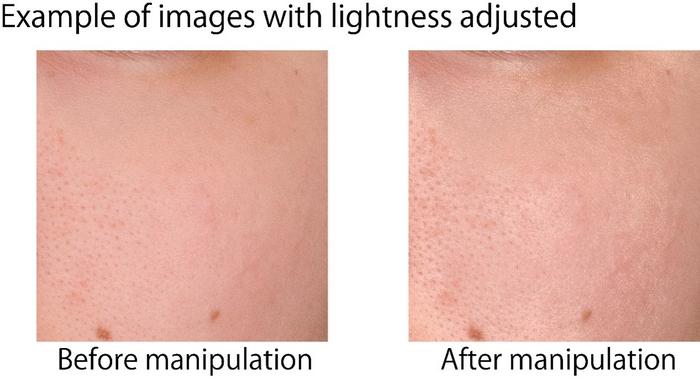
In a groundbreaking study conducted by a collaborative team from Toyohashi University of Technology, Kyushu University, and Pias Corporation, researchers have unveiled compelling insights into how high-spatial-frequency components of facial images influence perceptions of skin moisture. This innovative research, published on December 17, 2024, in the esteemed Journal of the Optical Society of America A, explores the profound relationship between visual cues and the impression of skin’s health. The findings will indubitably pique the interest of both the scientific community and the general public, as they illuminate the intricate dynamics underlying human visual perception.
The human face serves as a complex canvas that reveals much about an individual’s health. The physiological attributes of facial skin—such as moisture levels, glossiness, and overall texture—play a significant role in how observers perceive beauty and wellness. The researchers sought to investigate the specific visual factors that contribute to the perception of skin moisture and dryness, an area that has remained relatively opaque despite its societal relevance. By manipulating image attributes and conducting psychophysical experiments, they assessed how changes in skin lightness affect visual interpretations of moisture.
Participants in the study were shown a series of images featuring human faces, with varying manipulations to enhance or diminish certain lightness attributes. They were then tasked with rating these images based on the perceived moisture, glossiness, and overall attractiveness. The meticulous design of the experiment included conducting the trials in controlled lighting conditions to eliminate any external influences on participants’ judgments. The integrity of the experiment ensured that the responses were reflective of genuine perceptual experiences rather than extraneous factors.
Remarkably, the results demonstrated a consistent negative correlation between perceived skin moisture and image lightness. Skin images that had their high-spatial-frequency components enhanced—notably those increased in brightness—were perceived as drier than those without such manipulations. This perceptual shift was attributed to the exaggeration of white lines and pores, which are often associated with skin dryness, thus corroborating the researchers’ hypotheses about the visual cues that denote moisture levels. The study effectively corroborates that the visual system utilizes cues inherent to skin texture and lightness distribution to formulate assessments of an individual’s skin condition.
Beyond merely documenting perceptual biases, this research delves deeper into the psychological underpinnings of beauty standards. The implications of these findings extend to the marketing of skincare products, where visual representation can sway consumer preference significantly. Understanding precisely how visual cues are interpreted can empower brands to design imagery that conveys desired messages regarding moisture and overall skin health. Such strategic visual communication could enhance customer engagement, leading to better purchasing decisions in the beauty industry.
Yuya Hasegawa, a notable co-author and doctoral student within the Department of Computer Science and Engineering, articulated the essence of the study’s inquiry: understanding the genesis of skin perception cues. The researchers were intrigued by the daily variations in skin appearance, influenced by multiple factors translating to individual differences in judgment. This curiosity culminated in a meticulously designed study that elucidates how visuals can manipulate perceptions so powerfully.
Delving deeper into the implications of visual cues related to skin moisture, the researchers noted that this understanding could significantly impact healthcare assessments as well. For healthcare professionals, accurate assessments of skin conditions are crucial in diagnosing various dermatological issues. By honing in on and understanding these perceptual dynamics, clinicians may enhance their evaluative techniques, ultimately leading to improved patient care and outcomes.
The study opens avenues for further exploration in understanding how visual perception extends beyond skin moisture to encompass other physiological aspects reflected through facial attributes. With this preliminary exploration revealing clear implications regarding moisture perception, future studies are poised to address fewer understood aspects, such as how to convey increased moisture visually. How do various visual treatments alter perceptions and expectations in different skin conditions? This and many other critical questions remain at the forefront of ongoing research.
The research itself was meticulously conducted and received funding through reputable avenues, namely the JSPS Grants-in-Aid for Scientific Research, indicative of the rigorous academic underpinning this investigation boasts. As researchers continue to uncover nuanced visual cues that reflect skin health, the implications for both the science of cognition and practical applications in the beauty and healthcare industries remain infinite.
The revelation that skin lightness can lead to misinterpretations of moisture levels beckons a reevaluation of visual representation standards in both media and product design. Brands must now consider the psychological effects of lighting, texture emphasis, and the complexities of human perception while representing beauty in marketing campaigns. As visual media continues to consume our daily lives, understanding these implicit cues becomes pivotal for successful communication.
In conclusion, the research spearheaded by an innovative collective from Toyohashi University of Technology and its collaborators highlights an intriguing intersection between cognitive psychology and visual communication. By shedding light on the perceptual cues behind skin moisture, the potential applications and ramifications of this understanding ripple far beyond the realms of academia. Whether through the lens of marketing, healthcare professionals, or individual consciousness, the implications of how we perceive skin moisture are profound, reshaping narratives around beauty, health, and wellness in the modern landscape.
Subject of Research: Not applicable
Article Title: Visual cues for moisture perception of facial skin: A pilot study on the effects of enhancing high-spatial-frequency components of skin lightness to decrease perceived moisture levels in young Asian observers
News Publication Date: 17-Dec-2024
Web References: https://doi.org/10.1364/JOSAA.536898
References: Hasegawa, Y.†, Tamura, H.†*, Kanematsu, T., Yamada, Y., Ishiguro, Y., Nakauchi, S. & Minami, T. (2025). Visual cues for moisture perception of facial skin: A pilot study on the effects of enhancing high-spatial-frequency components of skin lightness to decrease perceived moisture levels in young Asian observers, Journal of the Optical Society of America A, 42(5), B23-B33, https://doi.org/10.1364/JOSAA.536898.
Image Credits: COPYRIGHT(C)TOYOHASHI UNIVERSITY OF TECHNOLOGY. ALL RIGHTS RESERVED.
Keywords
Visual perception, Skin, Cognitive psychology, Perceptual processes.





